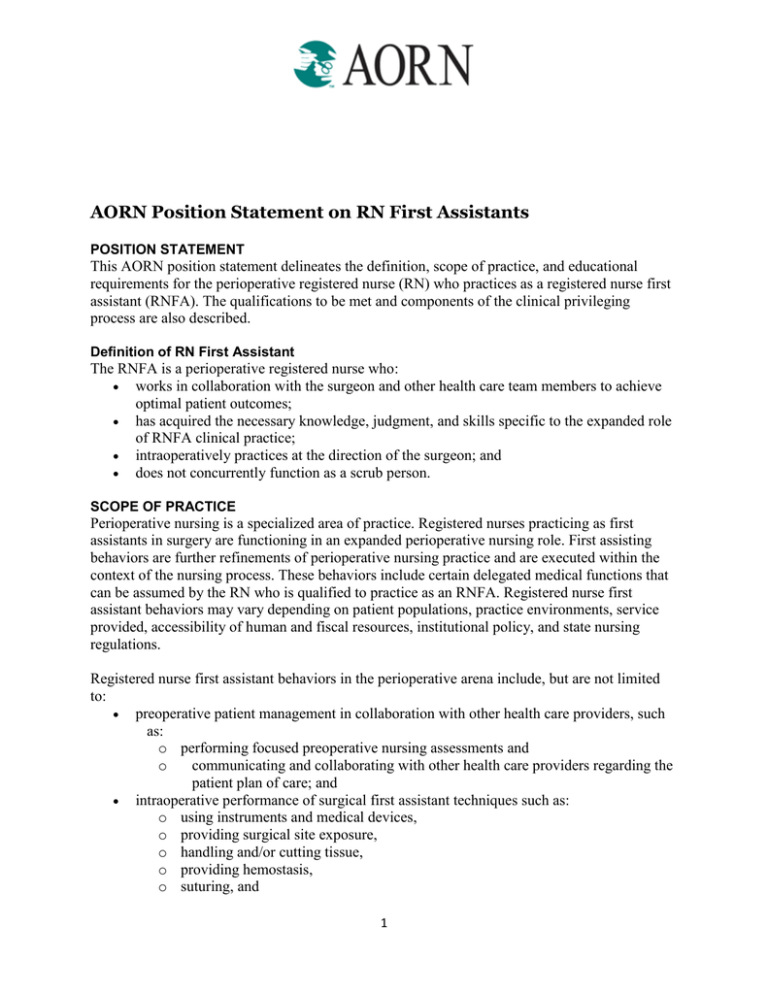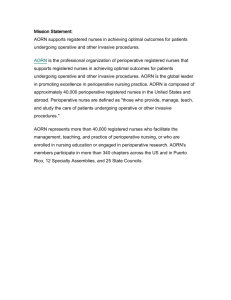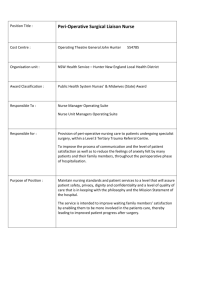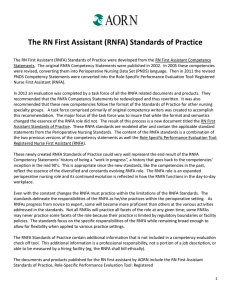AORN Position Statement on RN First Assistants
advertisement

AORN Position Statement on RN First Assistants POSITION STATEMENT This AORN position statement delineates the definition, scope of practice, and educational requirements for the perioperative registered nurse (RN) who practices as a registered nurse first assistant (RNFA). The qualifications to be met and components of the clinical privileging process are also described. Definition of RN First Assistant The RNFA is a perioperative registered nurse who: works in collaboration with the surgeon and other health care team members to achieve optimal patient outcomes; has acquired the necessary knowledge, judgment, and skills specific to the expanded role of RNFA clinical practice; intraoperatively practices at the direction of the surgeon; and does not concurrently function as a scrub person. SCOPE OF PRACTICE Perioperative nursing is a specialized area of practice. Registered nurses practicing as first assistants in surgery are functioning in an expanded perioperative nursing role. First assisting behaviors are further refinements of perioperative nursing practice and are executed within the context of the nursing process. These behaviors include certain delegated medical functions that can be assumed by the RN who is qualified to practice as an RNFA. Registered nurse first assistant behaviors may vary depending on patient populations, practice environments, service provided, accessibility of human and fiscal resources, institutional policy, and state nursing regulations. Registered nurse first assistant behaviors in the perioperative arena include, but are not limited to: preoperative patient management in collaboration with other health care providers, such as: o performing focused preoperative nursing assessments and o communicating and collaborating with other health care providers regarding the patient plan of care; and intraoperative performance of surgical first assistant techniques such as: o using instruments and medical devices, o providing surgical site exposure, o handling and/or cutting tissue, o providing hemostasis, o suturing, and 1 o wound management; and postoperative patient management in collaboration with other health care providers in the immediate postoperative period and beyond, such as: o participating in postoperative rounds and o assisting with patient discharge planning and identifying appropriate community resources as needed. Preparation of the RNFA The complexity of knowledge and skill required to effectively care for recipients of perioperative nursing services necessitates nurses to be specialized and to continue their education beyond generic nursing programs. Effective January 1, 2020 the education level for entry into an RNFA program and, subsequently, RNFA practice will be the baccalaureate degree. AORN recommends that RNs who were practicing as RNFAs prior to January 1, 2020 and do not have a baccalaureate degree be permitted to continue to practice as RNFAs. Perioperative nurses who wish to practice as RNFAs should develop a set of cognitive, psychomotor, and affective behaviors that demonstrate accountability and responsibility for identifying and meeting the needs of their perioperative patients. This set of behaviors: begins with and builds on the education program leading to licensure as an RN, which teaches basic knowledge, skills, and attitudes essential to the practice of perioperative nursing; includes diversified clinical experience in perioperative nursing; and includes achievement of certification in perioperative nursing (CNOR). Further preparation to assume the role of RNFA is then attained by completion of an RNFA program that: is equivalent to six (6) semester credit hours of formal, post-basic nursing study; meets the “AORN standards for RN first assistant education programs”1; and requires a baccalaureate degree for entry into the program after January 1, 2020. Qualifications for RNFA Practice The minimum qualifications to practice as an RNFA include: certification in perioperative nursing (CNOR); successful completion of an RNFA program that meets the “AORN standards for RN first assistant education programs”1; compliance with all statutes, regulations, and institutional policies relevant to RNFAs; and a baccalaureate degree, with the exception that the RNFA practicing prior to January 1, 2020, may continue to practice at his or her existing level of education. 2 Continued Competency The RNFA: demonstrates behaviors that progress on a continuum from basic competency to excellence, maintains CNOR status, and is encouraged to achieve and maintain CRNFA certification when educational and experiential requirements have been met. Clinical Privileging for the RNFA The facility(ies) in which the individual practices should establish a process to grant clinical privileges to the RNFA. This process should include mechanisms for: verifying individual RNFA qualifications with the primary source, evaluating current and continued competency in the RNFA role, assessing compliance with relevant institutional and departmental policies, defining lines of accountability, incorporating peer and/or faculty review, validating continuing education relevant to RNFA practice, and verifying physical ability to perform the role. RATIONALE Historically, perioperative nursing practice has included the role of the registered professional nurse as an assistant during surgery. As early as 1977, documents issued by the American College of Surgeons supported the appropriateness of qualified RNs to first assist.2 The American College of Surgeons continues to support the role as evidenced in a study on assistants at surgery in 2011.3 AORN officially recognized this role as a component of perioperative nursing in 1983 and adopted the first “Official statement on RN first assistants (RNFA)” in 1984.4 All state boards of nursing recognize the role of the RNFA as being within the scope of nursing practice. The decision by an RN to practice as a first assistant is to be made voluntarily and deliberately with an understanding of the professional accountability that the role entails. REFERENCES 1. AORN standards for RN first assistant education programs. In: Perioperative Standards and Recommended Practices. Denver, CO: AORN, Inc; 2012:749-751. 2. American Colleges of Surgeons: statement and qualifications for surgical privileges in approved hospitals. Bull Am Coll Surg. 1977;62(4):12-13. 3. Physicians as assistants at surgery: 2011 study. American College of Surgeons. http://www.facs.org/ahp/pubs/2011physasstsurg.pdf. Accessed June 22, 2012. 4. Task force defines first assisting. AORN J. 1984;39(3):403-405. 3 Original approved by the House of Delegates, Atlanta, March 1984 Revision approved by the House of Delegates, March 1993 Revision approved by the House of Delegates, April 1998 Revision approved by the House of Delegates, March 2004 Revision approved by the House of Delegates, December 2005 Revision approved by the House of Delegates, March 2010 Revision approved by AORN Board of Directors, August 2012 Editorial revision approved by AORN Board of Directors, December 2013 Sunset review: August 2018 4


